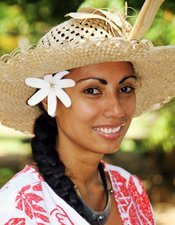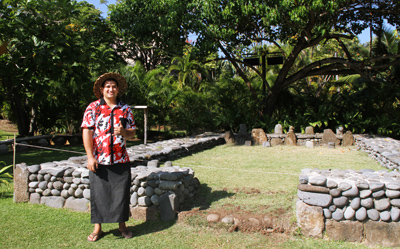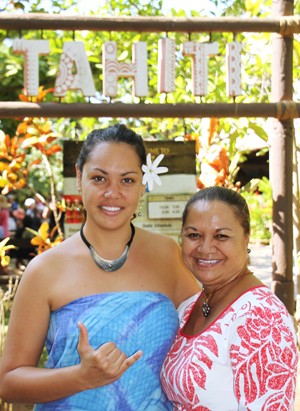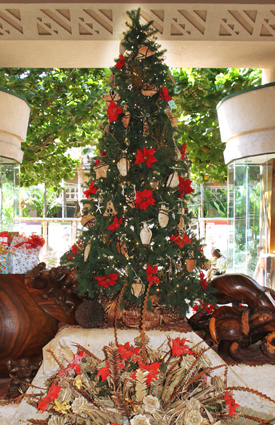

Surprise!
Our Tahitian Village guests love eating free samples
Heitiare Pane’e, our PCC Tahitian Village “chiefess” or manager, reports that sampling faraoa opa’a or traditional Tahitian coconut bread is one of the favorite guest activities in the village.
“We explain to them how it’s made from shredded coconut and cooked in the ahi ma’a or underground oven,” she says. “Then we pass out tasty, free samples.”
Don’t you wish you could try some, too?
So, what do you think is the second-most favorite thing to watch, or even try, if you dare, in the Tahitian Village?

Tevahine
Tamure — Tahitian dancing and drumming:
“Our Tahitian dancing is also very popular with guests — the hips moving for the women, and knees knocking for the men, plus the drumming attracts people to our village,” Pane’e says.
She explains that traditional Tahitian dancing or tamure uses various rhythms and several types of drums, loosely divided between to’ere — stout wooden branches of various lengths and diameters to create various pitches with a long slit carved out on one side — and pahu, which are the more customary hollowed-out logs covered by skin on one or both ends and played with either the hands or drumsticks.
“The pitch each to’ere produces depends not only on its size, but on whether the drummer hits it near the end or in the middle. Watch their hands, and you’ll see they’re almost always moving up and down the to’ere,” she continues.
“The pahu or regular drums, also come in various sizes and produce different pitches,” she continues. “The smaller fa’atete, for example, has a higher pitch. It’s played with drumsticks and the sound is usually used as a filler to the to’ere rhythms. Whether the drummers are playing to’ere or pahu, it takes a lot of stamina and outstanding rhythm to generate the enchanting sounds of Tahitian drumming.”

Ranui Arapari in front of the marae
The marae — a small enclosure with a low, stone wall, is one of the newer features in the PCC’s Tahitian Village.
“Our people used to do sacred ceremonies in their marae:
The appointing of a new chief or priest, marriages — the only time women were allowed in there, planning, welcoming new chiefs and important visitors, preparing for war, and making offerings to the gods.”
“What’s special about this marae is that we brought the stones for the wall from Papeno’o, Tahiti. There are a lot of marae in that valley, and ours is modeled after one of them, which I’ve visited. We also brought a well-known cultural specialist from Tahiti, Heremoana Mamaatuatehautapu, who was recently promoted as the Minister of Culture for all French Polynesia, to help build it.”
French Polynesians, with increasing accent on the first word:
“Many people don’t realize that Tahiti is part of France,” Pane’e says. “The first language for many of us is French. Our education is in French. We are French citizens.”
“In my family, both sets of my grandparents only spoke Tahitian, but my parents wanted us to learn to speak French and excel in school, because we were raised right outside of Papeete, the capital. Speaking Tahitian at school was not allowed, but on weekends it was family time and we would speak Tahitian. I only learned English when I came to school at BYU–Hawaii.”
Pane’e adds that her maternal grandmother originally comes from the island of Ana in the Tuamotu archipelago, where she spoke that dialect. “I can understand some of the words, but it’s different from Tahitian. Some of the other Tahitians who have worked at the PCC in the past also have roots in the Tuamotus.”

Heilani & Pane’e
Pane’e points out that Heilani Ahuura Tinirauarii, a part-time BYU-Hawaii student worker in the village, is an example of a young Tahitian who doesn’t speak her Polynesian language.
“My parents don’t speak it, either, so they didn’t speak it to me,” says Heilani, who was born at nearby Kahuku when here parents were young BYU-Hawaii students working part-time at the Polynesian Cultural Center. The family returned to Tahiti while she was still a baby.
“I took classes in Tahitian in school for six years, but it didn’t really work for me; but when I went to my grandparents’ house, they would talk to me in Tahitian. I could understand, but I would answer them in French,” she says with a delightful accent.
The language situation aside, Heilani is like most modern Tahitians who are still very interested in other aspects of their Polynesian heritage. “I started to learn how to dance when I was just three years old. We have many tamure classes and schools in Tahiti. Then every July we have the heiva — a large national competition for the best groups.”
Ranui Arapari is another example of a young adult adapting to his traditional heritage. He was born in Florida, where his parents were entertainers, raised in California, but now lives in Hawaii. “My dad is from Mo’orea and my mom is from Hawaii,” he says in fluent English.
“I didn’t really get into Tahitian culture until I was about 17, but since then I’ve picked up drumming, playing music and singing. I did luaus back in California for a few years, and now I work at the PCC.
Nui says he hadn’t originally planned to work at the Center, “but I injured my knee surfing and I needed a job where I could sit down, so I ended up as a PCC night show drummer; then Heitiare asked me to work fulltime in the Tahitian Village.”
“It means everything to me. Tahitian culture is now my passion,” he says. “I’ve been there a couple of times but I wasn’t raised there. I didn’t grow up in that lifestyle, but every aspect of the culture now interests me a lot. It gives me a drive to keep learning, and it’s an honor to express what I do know to the guests who come here.”
 Joyeux Noël — Merry Christmas, in French — Pane’e wishes us. She recalls, “We had Christmas trees with lights and balloons. Of course, Christmas in Tahiti actually starts with a dinner on Christmas Eve, which we call réveillon. We prepare the best meal all day long. That evening we eat lots of good stuff, including oysters, turkey, and bûche de Noël — a delicious chocolate Yule log dessert.
Joyeux Noël — Merry Christmas, in French — Pane’e wishes us. She recalls, “We had Christmas trees with lights and balloons. Of course, Christmas in Tahiti actually starts with a dinner on Christmas Eve, which we call réveillon. We prepare the best meal all day long. That evening we eat lots of good stuff, including oysters, turkey, and bûche de Noël — a delicious chocolate Yule log dessert.
Some people have midnight religious services, and the next day we open our gifts. Years ago, only children got gifts; but now, everyone gets Christmas presents.”
“Remember, too, December in Tahiti is summertime, and it’s hot, so the beaches are usually full on Christmas day.”
“In our culture, family comes first,” Pane’e says. “Faith in God, faro’o, and here or arofa — love for others — are also very important values.
We hope you feel this when you visit our village at the Polynesian Cultural Center.”
Story by Mike Foley

Mike Foley, who has worked off-and-on
at the Polynesian Cultural Center since
1968, has been a full-time freelance
writer and digital media specialist since
2002, and had a long career in marketing
communications and PR before that. He
learned to speak fluent Samoan as a
Mormon missionary before moving to Laie
in 1967 — still does, and he has traveled
extensively over the years throughout
Polynesia and other Pacific islands. Foley
is mostly retired now, but continues to
contribute to various PCC and other media.






Recent Comments